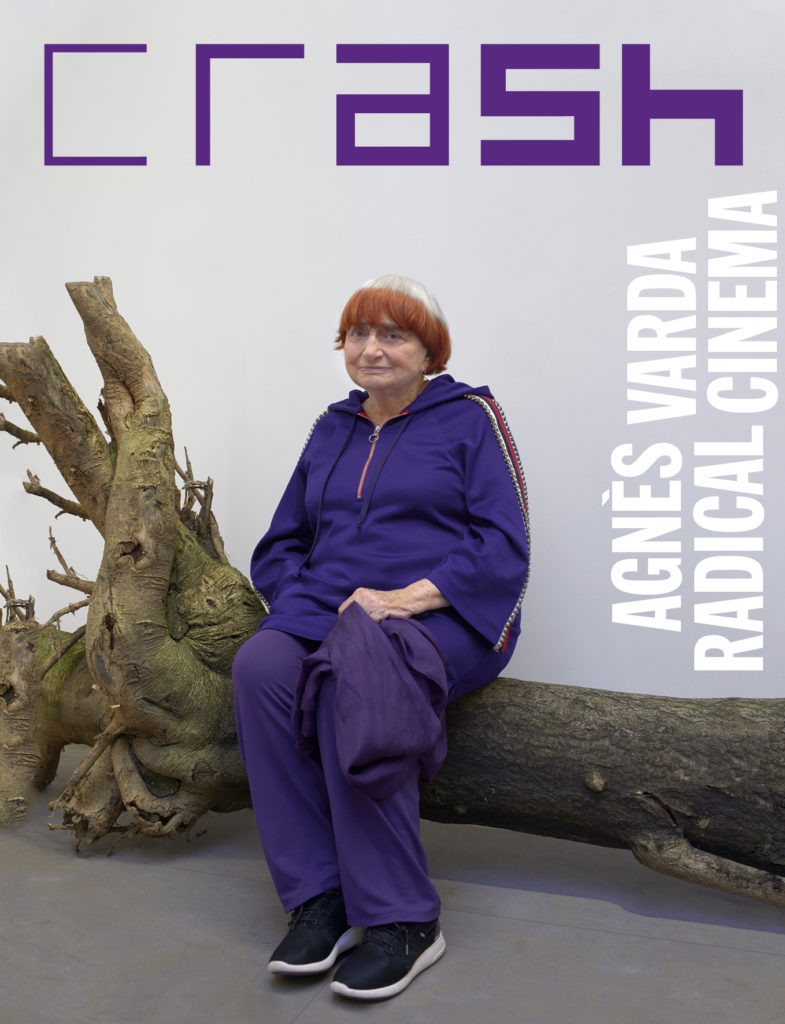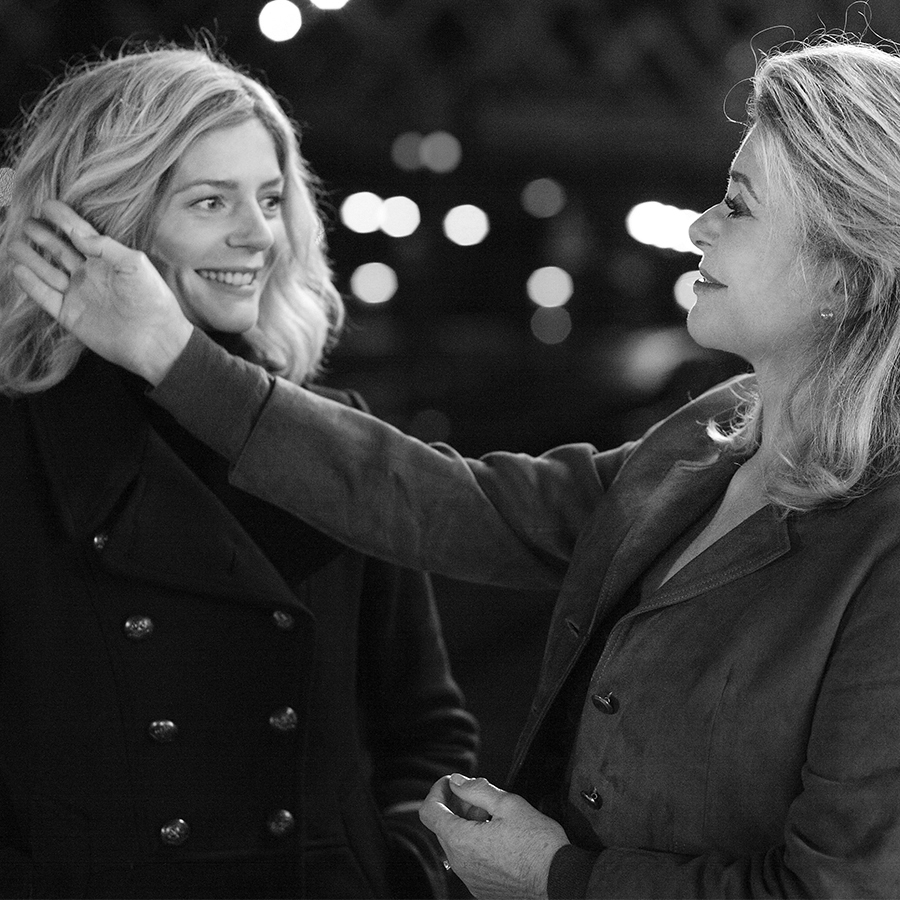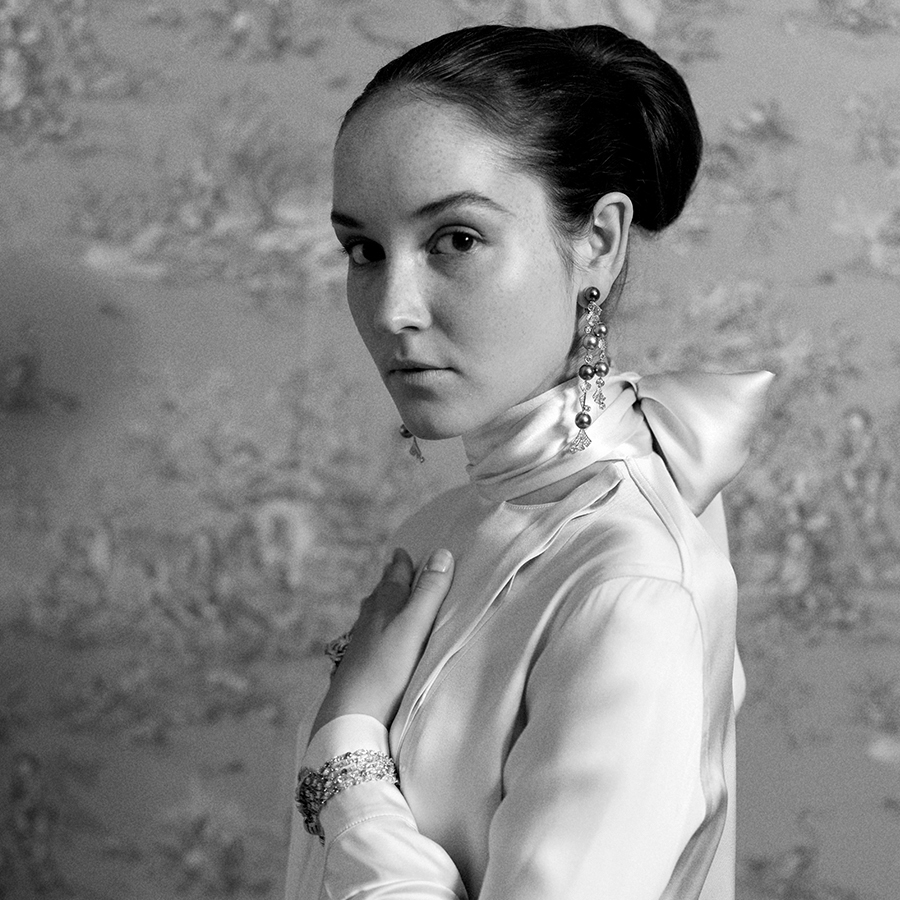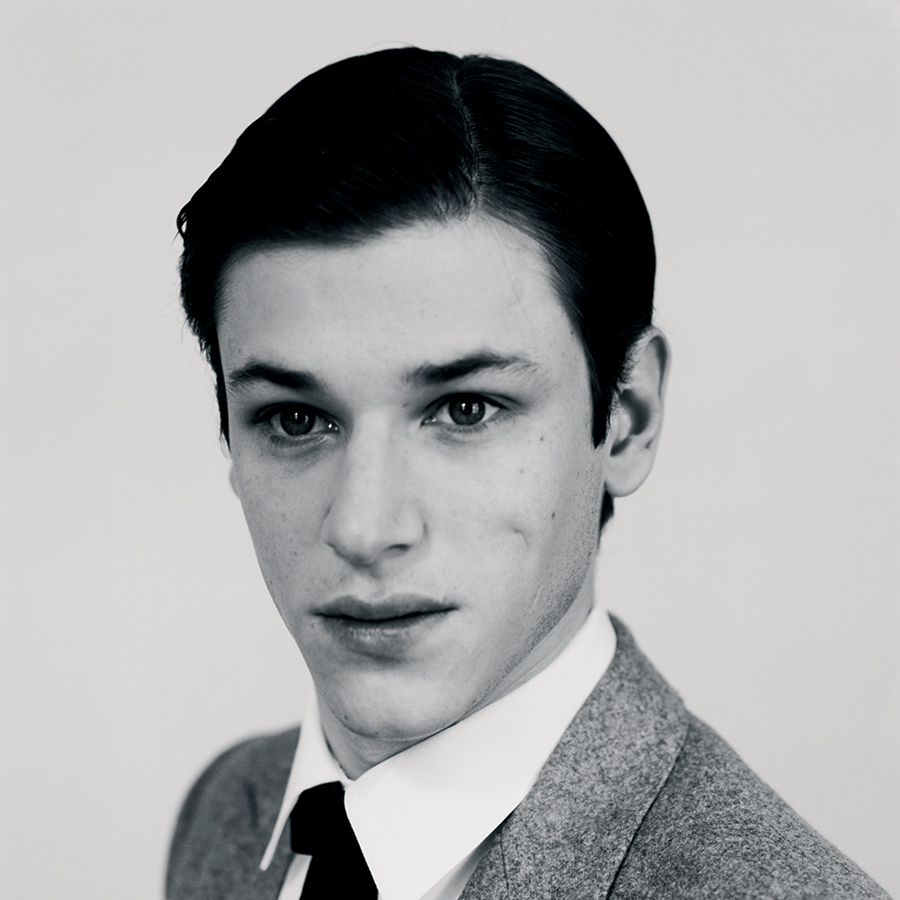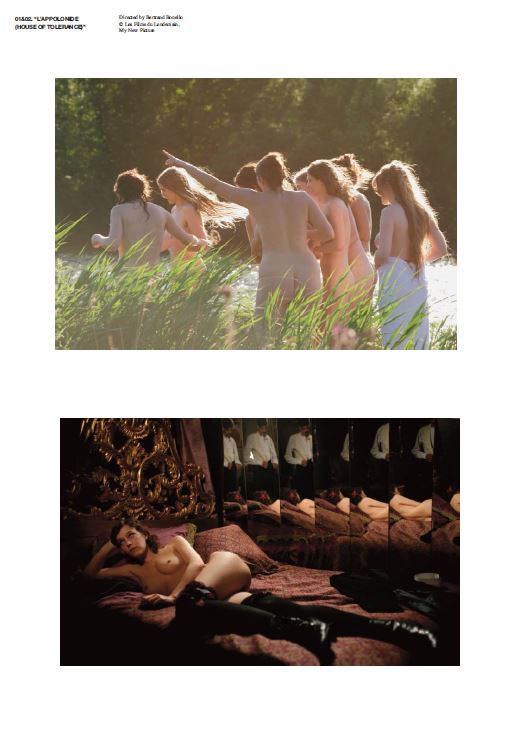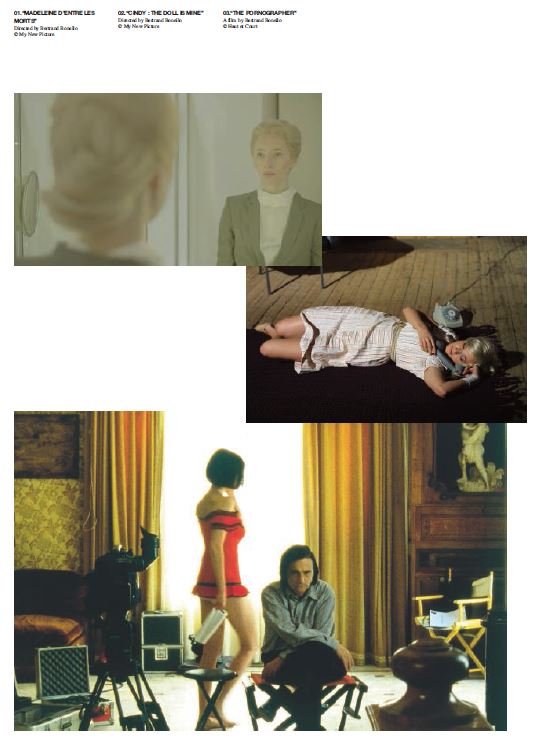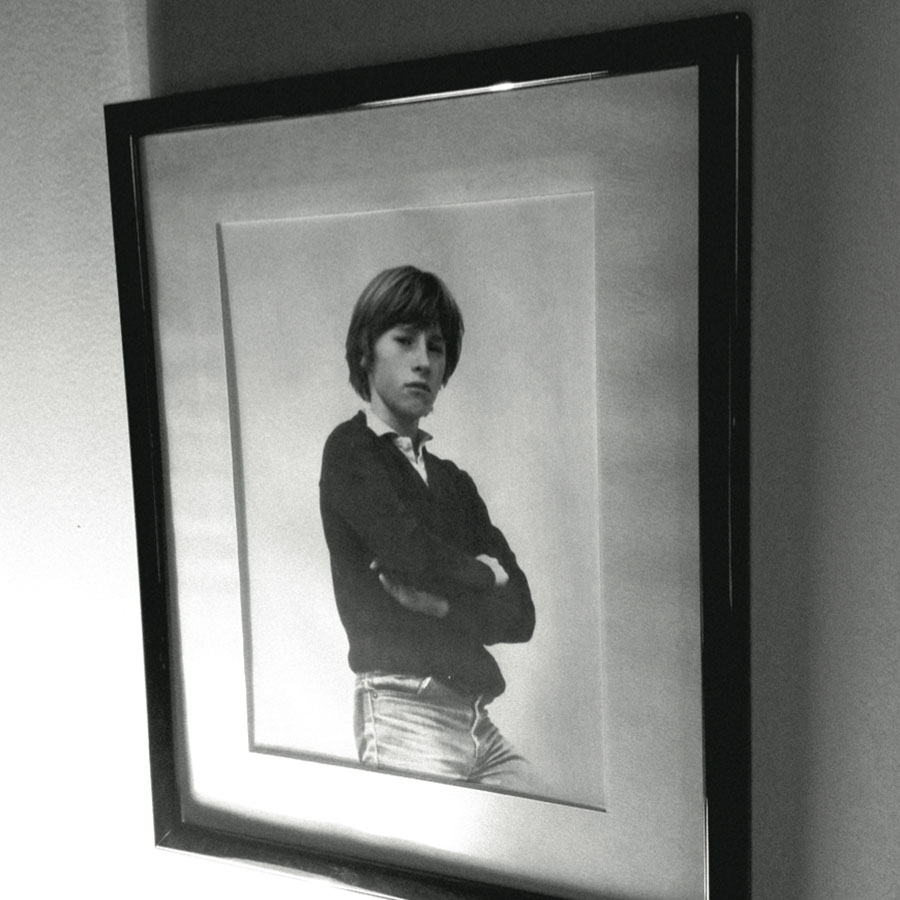
BERTRAND BONELLO ON CINEMA
By Crash redaction
A RARE REPRESENTATION OF A UNIQUE KIND OF FILMMAKING, BERTRAND BONELLO IS EVERYWHERE THIS FALL. NOT ONLY WILL HE RELEASE HIS NEW FILM “SAINT LAURENT”, A PERSONAL LOOK AT THE GREAT COUTURIER, HE ALSO HAS AN EXHIBITION AT THE CENTRE POMPIDOU ENTITLED “RÉSONANCES”. A MEETING WITH A DIRECTOR – AND MUSICIAN – OF A SUPREMELY SINGULAR TALENT.
Some may have caught a glimpse of him at the latest Cannes Film Festival, where he showed up in extremis to present his vision of designer Yves Saint-Laurent with his film “Saint Laurent”. But haste is no friend to the artist: the film fared poorly at the festival and it was quickly sent back to the editing room… In high fashion, everything is a question of cut and silhouette. So the film fell back into the director’s hands before it was finally ready-to-view. In the meantime another YSL film was released, Jalil Lespert’s “Yves Saint Laurent”, which was considered the “official” biopic as it was commissioned and approved by Pierre Bergé. No worry for Bonello, as it gave him the freedom to imagine his own Saint Laurent, with no one to answer to and no “specifications” to meet. His film covers the ten years from 1966-1976, an essential period and – as they say in perfumery – the essence of the myth. A film in three acts, a fresco of a bygone era, a portrait of a tormented and destructive genius, “Saint Laurent” also marks a new direction in Bertrand Bonello’s work, as he explores new subject matter and experiments with a much larger budget. Alongside a graceful Gaspar Ulliel are performances by a surprising Louis Garrel, a playful Léa Seydoux and the legendary Helmut Berger in a savage and unsettling performance as an aging Yves Saint Laurent… Our meeting with Bertrand Bonello takes place in early August, at his home, not far from the Palais Royal. We talk about the upcoming film and the Centre Pompidou exhibition he is still busily preparing…
Can you tell us about your childhood and where you are from?
Bertrand Bonello: Well, I was born in Nice in 1968 and I stayed there until the end of high school. I lived in a big house that even had a name: L’Apollonide [this would later become the French title of “House of Tolerance”]. There were a lot of rooms in the house, and my parents invited lots of friends over, mainly artists, musicians… It was very enjoyable… My father was a lawyer, and my mother worked at the opera in Nice. In fact, I was immersed in music and my mother had me playing piano at five years old… I
listened to an enormous variety of music. Not only classical music, but also rock. Naturally we listened to a lot of opera at home: Wagner, Mozart and all the great Italians… My
personal favorite was Robert Schumann… Later I started listening to a lot of pop, and I even had a big hard rock phase… I listened to a lot of Iron Maiden, Judas Priest and
Motörhead… (laughs)… Then there was punk rock, the Clash, the Stranglers, Sex Pistols… Then the first U2 albums, and Brian Eno… Music was something else at that time, nowhere near as accessible as it is today. It’s difficult to realize, to even imagine if you didn’t live through it. And Nice was not Paris by any means. We planned excursions to London to get vinyls we had spent weeks and months searching for… All that work just to find one specific album. It made us appreciate it even more; we would listen to it over and over again… You would be reading a magazine and say to yourself: “I need to find this album. Absolutely.” We cared so much about music, and this isn’t the case today, that’s clear. Afterwards I played in my first rock band. It was called WHY, but later we became the Bonellos… Because I was the one who called all the concert venues and I gave my name when we booked shows. So people started calling us the Bonellos… (laughs)… And then I left for Paris when I was 18… I became a studio musician. I played a lot of organ actually, but also some piano, a Rhodes… Music is my first and greatest passion…
And how did things go in Paris?
Well, I played for quite a few people, from Carole Laure to Françoise Hardy, as well as Daniel Darc and Elliott Murphy, and lots of others whose names I prefer to forget… I was mainly working at Studio +, which is still around I think… It was the end of the 80s, a very, very tough time for French music, in terms of quality I mean. And “home studios”
weren’t around yet, so it cost a lot to record something or produce an album… I got bored with it fairly quickly, and I intuitively started looking for a new path, something else to do… And so I got into film, but without any intense passion. I didn’t go to the movies very often, and didn’t have any film background at all. All I had was a desire to make films. So I got my finances in order and got started by directing a short film. It was called “Juliette+2” and I filmed it in Poland… It was very basic, not a masterpiece, but a first step. I hadn’t gone to any school; I just started writing. I directed a second short in 1996 with artist Jean- Charles Blais. It was a Pasolini adaptation called “Qui je suis”… I continued writing a bunch of scripts, and they were all very different… Then one of the scripts caught the attention of a producer: Carole Scotta. She had just started her production company called Haut & Court, and she believed in the script, she trusted me. So that’s how I shot my first feature, called “Quelque chose d’organique” (1998). And then I did “The Pornographer” in 2001, when I had the opportunity to direct Jean-Pierre Léaud…
It’s not very common for a director to come from music, instead of visual art or literature…
It’s true… There are a few others, though. I’m thinking of Jim Jarmusch or Vincent Gallo. But for me, music is an integral part of the project whenever I’m planning a film. Music is there as soon as I start working on the script, from the very first… In “Saint Laurent”, for example, music plays a special role, because it always comes out of the scene itself. It’s what we call diegetic sound. It’s a disc playing in a hall, or the music at a fashion show, and we even hear the rustle of clothing and the jingling of jewelry. It’s not music that’s been slapped onto the image, as is the case in many music videos or commercials… From the start of the project I wanted the music to have this “physical” presence. My first thought was Northern Soul, which is a unique genre. Then of course I thought of classical music, of opera and Maria Callas, a Saint Laurent favorite. And for certain scenes I even made some music myself, all with a Moog sound. By that I mean I used a synthesizer, in the Krautrock style that was all over the place in the mid-70s [such as Tangerine Dream, Kraftwerk and Klaus Schultz]. So there are three kinds of music in the film, one for each part: 1 – Day / The young man, 2 – Night / The rock star and 3 – Limbo / YSL – The rise of the “brand”…
It’s true that each part has its own tonality, its own light, its own mood…
Yes, that was very important. Light plays a strong role when the Saint Laurent world is invaded by Jacques de Bascher, a young man who is extremely seductive and at the same
time terribly destructive. And also incredibly tough in his attitude. I wanted to recreate that by using very strong, cold lighting. For example, the drug scenes are not shot in the
shadows but in a bright, violent light. With some possible reference to certain scenes in Stanley Kubrick’s “A Clockwork Orange”, where we see groups of young men in completely white, extremely “clinical” atmospheres… Jacques de Bascher, who is played by Louis Garrel, fascinated Saint Laurent, because of his ability to be fully in the present moment. There is no past and no future for this character…
Can you tell us how the idea first came about to do a film on Yves Saint Laurent?
Actually it was the Altmayer brothers, two producers, who asked me to do the film after they saw my last one, “House of Tolerance” (2011). My initial reaction was to say no,
because I was afraid I wouldn’t be able to do what I wanted. And you have to be careful when dealing with Yves Saint Laurent… Then as I thought about it and talked with
them, I realized I would have the chance to do exactly what I wanted, that I could take total control of the project. I was free to bring in my vision, with no compromises. So
the project started to take shape. And unlike the other film project on Saint Laurent, I didn’t have to answer to anyone. For me, the first step was to get rid of anything I
didn’t find interesting. There are so many different aspects of the character; there’s “too much”. So I chipped away at it, cutting as much fat as possible. Because, in the end, this
is also a very personal film… In fact, the “biopic” side wasn’t interesting for me. Though I did watch the big biopics released over the past few years, like “La Vie en Rose” and “My Way”… I also rewatched Scorsese’s “Aviator”, because there is a commonality with Yves Saint Laurent’s development: they are both personalities who, unlike many others, did not need to climb the social ranks. They were born into well-to-do families, so they didn’t have to fight to get rich, to survive… So I ended up sticking with a period in his life from 1967 to 1976, more or less. Then I sat down to work on the three parts of the film with my co-screenwriter, and to come up with scenes based on all the anecdotes, stories and events… Like the scene with the letter from Andy Warhol: How could we show the rise of Saint Laurent in the media, and the legendary Rive Gauche boutique, without falling into clichés and déjà-vu? So we had Warhol say that he and Saint Laurent are now the only two stars, which puts Saint Laurent on the same level as Warhol. In this way we see Saint Laurent achieving international celebrity. He’s a Star. Then we hear « Venus in Furs » by the Velvet Underground, but it’s not the version everyone knows, it’s the first
recording…
How does this film fit into your career?
For me it’s actually a continuation of “House of Tolerance”… In that film, as well, the events take place at the end of an era… And there is the same strong relationship between Beauty and Toughness… They also share the theme of confinement, though in “House of Tolerance” the confinement is involuntary, whereas in “Saint Laurent” you can see it as more voluntary. Even when Saint Laurent meets people, he is always and inescapably alone. And once these people leave, he goes back to his isolation… I’m thinking of the scenes where he meets Betty Catroux, then Loulou de la Falaise… But as far as themes go, I think my main concerns appear in all my films…
How did you choose the actors?
It was a rather long process. The first person I thought of was Helmut Berger. He came to mind pretty quickly. So I got his personal number and called him myself. It took some time for him to see what the project was about and what I wanted to do, but he was soon enthusiastic about it.
He’s impressive in the role of Yves Saint Laurent at the end of his life…
Yes, he’s absolutely perfect. His way of moving, his face, everything… And in the scene with the young man he calls Pascal, it’s quite uncanny. I actually thought up this scene
when I met Pascal Greggory. Because that’s who it is in the film. Pascal Greggory was kind enough to let me read a letter Saint Laurent wrote to him near the end of his life, at a time when he was in the grip of enormous distress, when he was extremely alone… At that moment, Saint Laurent was tired and suffering terribly. Pascal Greggory visited him from time to time to try to console him… And that’s what sparked this very powerful scene… Then I thought of Gaspar Ulliel for Saint Larent. I didn’t know him at the time. A funny thing he told me is that Gus Van Sant had already contacted him shortly before that to play Saint Laurent in one of his films, which didn’t end up happening… So Gaspar Ulliel took my offer. Then he took the time to really step into Saint Laurent’s skin, because 14 months actually passed between his decision to take the part and the film shoot… By the time we started shooting, he had become Saint Laurent. He simply let the designer speak through him. In fact, he’s the one who drew the sketches we see in the film… And he did it all with exceptional humility, total professionalism… Then I started to think about the other actors, like Jérémie Renier who is just as convincing in the role of Pierre Bergé. Then the women: Amira Casar for Anne-Marie Munoz in Saint Laurent’s atelier, Aymeline Valade, who is a model, for Betty Catroux, and Léa Seydoux for Loulou de la Falaise… Not to mention Louis Garrel for Jacques de Bascher….
And then you started shooting?
It took a long time to start shooting… For many reasons, some of which have already been published, like the fact that Pierre Bergé didn’t want this film to happen, for control reasons… And more than once we almost had to scrap the project. I have to say that Christophe Lambert, the producer at Europacorp, as well as Luc Besson both gave a lot of support to the project, defending it so strongly because they couldn’t understand why, in France today, it would be impossible to do an independent film, free from any control, about a figure like Yves Saint Laurent… It was a tough battle, but once shooting started, everything went extremely well. All the technicians had been ready for weeks. They did exceptional work. We shot almost the entire film in an immense townhouse in the 16th arrondissement of Paris, except the scenes in nightclubs and a few others… We were one big family of 80 people, and we organized big parties, for almost nine and a half weeks. It was a great atmosphere on set, with a lot of great memories… We also got approval for the film by the current owners of the YSL brand, the Kering group owned by Pinault. They gave their approval without asking for anything in return. So I was completely free.
And where does fashion fit into it all?
I’m not crazy about fashion, but I find the process interesting and always have. I had the chance to get really into this side of things because we didn’t have access to the original clothing, due to the disagreement with Pierre Bergé, so we had to reproduce everything. So in the end I got to see and supervise the entire process, and I think that made the clothes look even more alive. The fact that they had just been made, and not pulled out of an armoire… The whole fashion system, its economy, and the act of going from sketches to shows, it’s fascinating. Gaspar, as I said, drew all the sketches based on Saint Laurent’s own sketches…
At the end of the film, in French, you put: “Mise en scène: Bertrand Bonello”… And not « A film by » or “Réalisé par…”
“Réalisé”, I never understood why we say that. I don’t really know what it means, in fact. Maybe in English it makes more sense, “Directed by”, but in French, I think it’s better to say “Mise en scène”…
Like in theater…
Yes. Well, yes and no…






